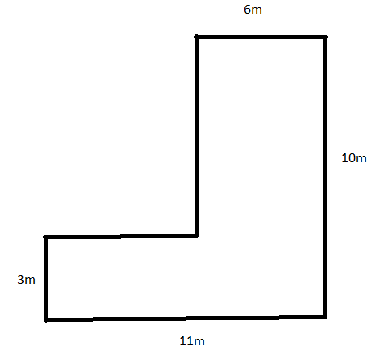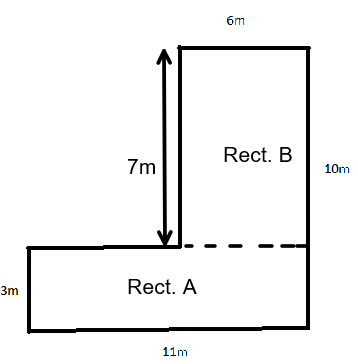
The diagram shows a floor plan 10m not to scale. Calculate the area.


Answer
442.2k+ views
Hint: According to the question, the area of irregular rectangles can be calculated in parts. As the above diagram is presented, we have to divide that figure in two regular shapes. We have to calculate the area of the two regular rectangles separately, and then add the final area that will be the final area of this irregular rectangle.
Formula used:
Complete step-by-step solution:
Here we divide the given shape in two rectangles as:

As the
So, we will be finding the area of rectangle A
Given,
So,
Now, finding the area of rectangle B, we get:
Given,
Calculating the area, we get:
Now, adding both the areas of rectangle A and rectangle B, we get:
So, the area of the irregular rectangle is 75 inches.
Note: A rectangle is a figure having four sides with four right angles. It has internal angles of
Formula used:
Complete step-by-step solution:
Here we divide the given shape in two rectangles as:

As the
So, we will be finding the area of rectangle A
Given,
So,
Now, finding the area of rectangle B, we get:
Given,
Calculating the area, we get:
Now, adding both the areas of rectangle A and rectangle B, we get:
So, the area of the irregular rectangle is 75 inches.
Note: A rectangle is a figure having four sides with four right angles. It has internal angles of
Latest Vedantu courses for you
Grade 11 Science PCM | CBSE | SCHOOL | English
CBSE (2025-26)
School Full course for CBSE students
₹41,848 per year
Recently Updated Pages
Master Class 12 Economics: Engaging Questions & Answers for Success

Master Class 12 Maths: Engaging Questions & Answers for Success

Master Class 12 Biology: Engaging Questions & Answers for Success

Master Class 12 Physics: Engaging Questions & Answers for Success

Master Class 12 Business Studies: Engaging Questions & Answers for Success

Master Class 12 English: Engaging Questions & Answers for Success

Trending doubts
How many ounces are in 500 mL class 8 maths CBSE

Name the states through which the Tropic of Cancer class 8 social science CBSE

How many ten lakhs are in one crore-class-8-maths-CBSE

Is the past tense for sink sank or sunk class 8 english CBSE

List some examples of Rabi and Kharif crops class 8 biology CBSE

What is the value of e infty class 8 maths CBSE





